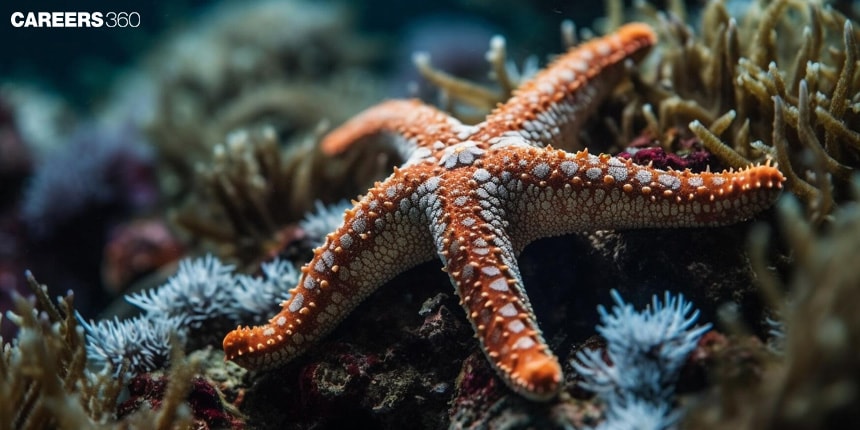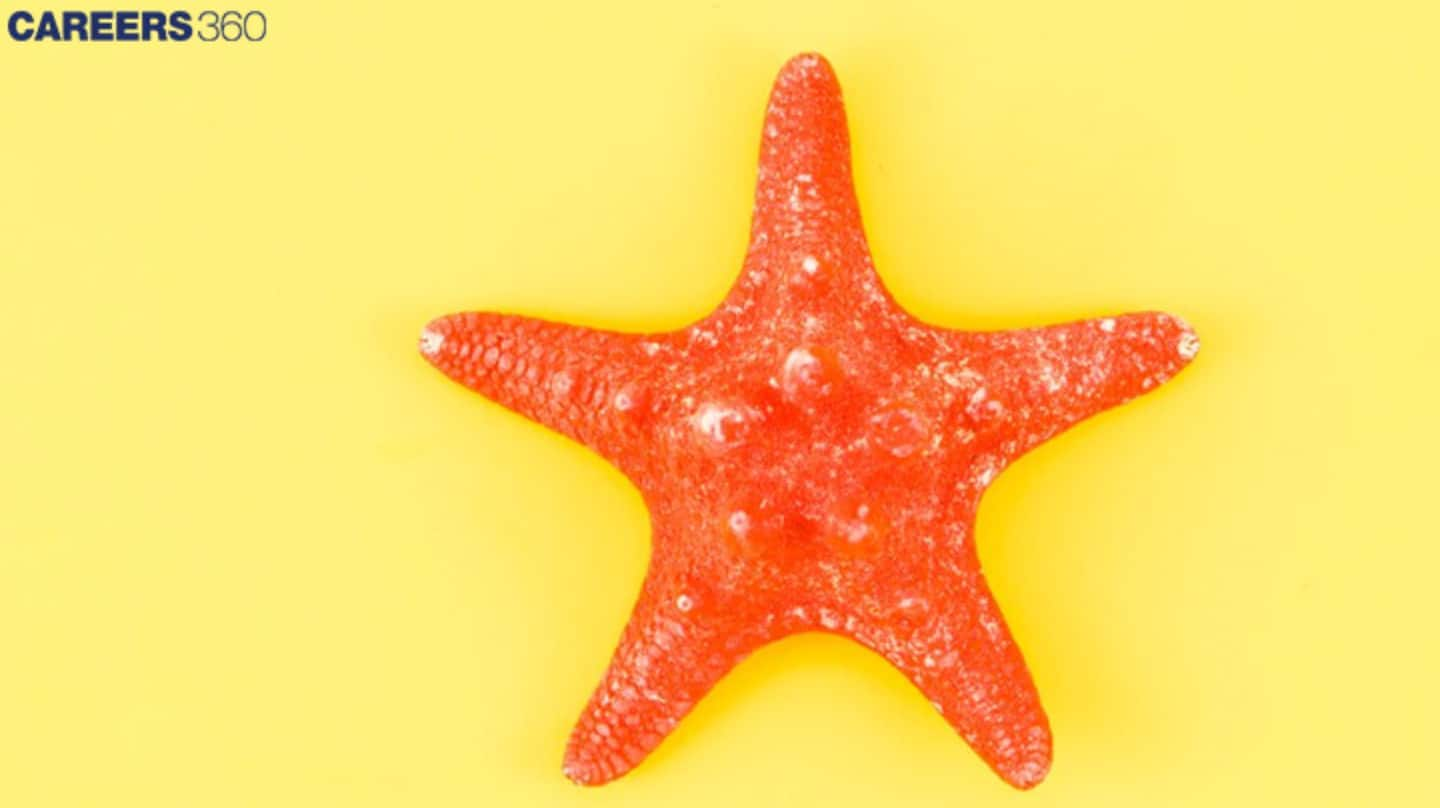Echinodermata: Definition, Characteristics, Classification, Exampales, Facts
The marine animals of starfish, sea urchins, sand dollars, brittle stars, and sea cucumbers belong to the phylum Echinodermata, which have characteristics such as radial symmetry, a calcareous endoskeleton, and a water vascular system. These all belong to the general characteristic features of phylum Echinodermata that distinguish them from all other marine organisms. The family members of Echinodermata are mainly aquatic animals. This is one of the important topics of biology from the chapter Animal Kingdom.
Don't Miss: Most scoring concepts for NEET | NEET papers with solutions
NEET 2025: Syllabus | PYQs | Crack NEET in 2 months - Study Plan
NEET Important PYQ & Solutions: Physics | Chemistry | Biology | NEET PYQ's (2015-24)
- Definition of Echinodermata
- Characteristics of Echinoderms
- Classification of Echinoderms

Definition of Echinodermata
Echinoderms constitute animals in the class phylum Echinodermata. The family members include starfish, sea urchins, sand dollars, and sea cucumbers. They share some unique features. Some of the general characteristics of the phylum Echinodermata include the radial symmetry of adults, possession of a calcareous endoskeleton that comprises calcium carbonate, and the presence of the water vascular system. Echinoderms have other features such as tube feet, which assist in movement, attachment, and food capture.
The animals belonging to the phylum Echinodermata are grouped such as starfish are part of Asteroidea, sea urchins and sand dollars of Echinoidea, Holothuroidea for sea cucumbers, Ophiuroidea for brittle stars, and Crinoidea for sea lilies. Such examples by echinodermata tell about the richness of this phylum.
Echinoderms are very important to marine ecosystems. By feeding on algae, preying on other invertebrates, and bioturbating the seabed, they establish balance within the environment. They are often involved in biogeochemical processes, keep diversity in the ocean, and make benthic habitats healthy. The general characteristics of echinodermata make them crucial for the maintenance of health in the aquatic ecosystem.
Also Read
Characteristics of Echinoderms
Some basic characteristics of Echinoderms are discussed below:
Radial Symmetry
Echinoderms are marine animals in the phylum Echinodermata which exhibit radial symmetry, usually pentameral. It allows for an equal distribution of sensory and feeding organs that enables interaction with the environment from all sides.
Endoskeleton Composition
The main characteristics of echinodermata include an endoskeleton that is composed of calcareous ossicles which are mainly composed of calcium carbonate. The ossicles allow rigidity with flexibility enabling the body to be supported in several forms.
Water Vascular System
The characteristic water vascular system is fluid-filled canals. It aids in movement, feeding, and respiration. Echinoderms move with tube feet and also use hydraulic pressure in handling the food.
Pedicellariae and Spines
On the calcareous plates the surface of echinoderms there is the presence of pedicellariae or spine-like organs and spines. These help in defence, cleaning, and sometimes trapping food. Such is one of the salient characteristics of echinodermata.
Regeneration Abilities
Echinoderms are remarkable for their remarkable regenerative capabilities. They can regenerate body parts lost, which is a life-saving feature, especially after an injury or attack. This is an important survival trait in general characters of echinodermata.
These characteristics of Echinodermata such as radial symmetry, endoskeleton, water vascular system, pedicellariae and regeneration give these animals a distinct flavour and place them as unique and important marine organisms.

Classification of Echinoderms
Some of the basic classification of Echinoderms is discussed below:
Class Asteroidea (Starfish)
Starfish, or sea stars, are marine animals falling in the group Echinodermata. They are star-shaped, with a stiff body, but some species have more than five arms. Their bodies contain a central disc and a disc-like series of arms covered with tube feet, which enable them to move and feed. Starfish are predators and carnivores and are important components in ocean food chains.
Class Ophiuroidea (Brittle Stars)
Brittle stars have long, slender arms separated from their central disk unlike starfish, they locomote by moving with a body covered in arms rather than using tube feet. Most brittle stars feed on detritus, consuming small amounts of organic materials mixed with minute organisms.
Class Echinoidea (Sea Urchins and Sand Dollars)
The sea urchins are spherical with long spines, but the sand dollars are flat and circular. Both are covered with a hard outer cover called a test. Some sea urchins, like butterfly urchins, feed on algae and thus help control the growth of it, whereas the sand dollars feed on sediment particles. These animals are important examples of characteristics of phylum echinodermata.
Class Holothuroidea (Sea Cucumbers)
Sea cucumbers are soft-bodied, elongated sea creatures that live on the sea floor. They play a large role in nutrient recycling and oxidation of organic matter by turning over sediment on the sea floor. Some species have a defence mechanism in which they expel their internal organs when threatened.
Class Crinoidea (Feather Stars and Sea Lilies)
Feather stars and sea lilies have branched arms that extend from the central disc, which they use in filter-feeding by capturing food particles in the water. Sea lilies are usually attached to the seabed using a stalk, but feather stars can move around freely. These are considered primitive members of the general characteristics of phylum Echinodermata, with its first appearance traced back to the Paleozoic era.
Also Read
Recommended video for Phylum Echinodermata
Frequently Asked Questions (FAQs)
The Phylum Echinodermata includes sea stars, brittle stars, sea urchins, sand dollars and sea cucumbers and these are marine animals that possess radial symmetry, a water vascular system and calcium carbonate endoskeleton. It generally has five-rayed symmetry and locomotory and feeding organs in the form of tube feet.
The water vascular system is another system of Echinoderms that is relevant for movement, ingestion, and respiration. This comprises several of chambers filled with water with an opening to the tube feet and worked by muscular action and is governed by a ring canal.
Feeding in echinoderms is mostly obtaining food by prehension and digestion Later developed sexual and asexual modes of reproduction. Sexual reproduction in fish has external fertilization in which sperms and eggs are released into the water and fertilizing occurs. In asexual reproduction, the organisms can be regenerated fully to form other individuals and body parts that were lost can grow into fully adult organisms. The process through which they evolve to adulthood mainly entails a period of a free-moving larval stage (for instance; bipinnaria, or doliolaria larva).
Echinoderms are carnivores/omnivores that affect populations of other sea organisms as predators/scavengers/grazers. They are also involved in nutrient cycling as well as the architecture of the habitat like the reef builders such as corals which are significant sources of diversity.
As described below, echinoderms have the following economic importance. Some species such as sea cucumbers and some types of sea stars are being read sources of fishery and have market value being used in food preparations by some cultures. Another classification is based on the species’ uses, for example, some sea urchins have significant applications in biomedicine because the animals are capable of regenerating their tissues. Also, their calcium carbonate skeletons are utilised in the making of lime and fertilizer.
Also Read
29 Nov'24 12:52 PM
26 Nov'24 04:23 PM
26 Nov'24 04:19 PM